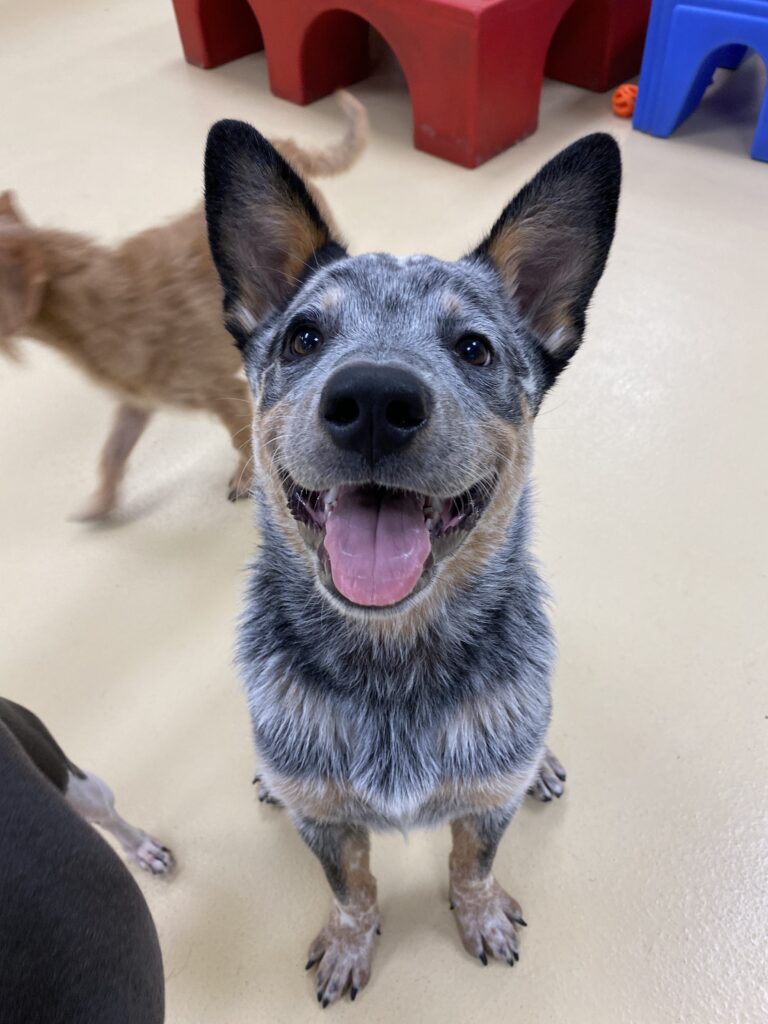
It is important to remember that a deaf dog can do just about everything a hearing dog can!
The only difference is that you communicate through hand signals and body language versus a verbal command. They play with toys, go for walks, give cuddles, do obedience training, and everything in between!
First, we will talk about how deafness occurs in dogs.
Like with humans, deafness can be hereditary and present at birth. Other times, deafness can be caused by a traumatic accident, disease, or appear as we age.
For some breeds, like Cattle Dogs or Dalmations, hereditary or congenital deafness is common. Congenital deafness can affect either one or both ears' hearing abilities. Congenital deafness is generally associated with a white coat and blue eyes. This is most common when two merle or white dogs are bred together.
Owning a deaf dog is a very rewarding and unique experience.
Since deaf dogs rely so much on their other senses, they are extremely in tune with their owners. Deaf dogs rely on their owners to communicate with them via body language, hand signals, and even facial expressions! Because of this, their bond with their owner is unique and special. They are highly attentive to their owners.
As an owner of a deaf dog, you have to be sure that you are looking out for them.
You have to remember that deaf dogs are simply that: deaf! This means you have to be aware of their surroundings for them. They should never be off-leash when near a busy street or area because they will not be able to hear the sounds of traffic or a car horn honking. If they are going to be off-leash, it should only be in a safe, well-fenced area.
Another thing to consider is making sure they are not startled when you, a family member, friend, or even stranger approach them. Deaf dogs will still feel vibrations from the floor, so tapping your foot when approaching from behind is an excellent way to get their attention calmly. Also, a gentle touch or pet will do the trick when waking them from sleep!
Teaching your deaf dog hand signals is essential in giving you and your dog a way to communicate.
There is a common misconception that training a deaf dog is more complicated than a hearing dog, but that is not the case! Deaf dogs do not have the distraction of noises while training, which can help them focus solely on you.
By teaching hand signals, you are creating a language for you and your dog to communicate with. Dogs will naturally check in with their owners, making it even easier to teach a deaf dog hand signals.
Here are some common hand signals:
- One finger points to eye - Watch Me. This cue is a great place to start and an essential first step! Your dog must learn they need to look to be able to watch what behavior you want them to perform. Whenever your dog looks directly at your eyes, reward them with a treat!
- Open hand, palm up - Sit. Sit is probably the most basic obedience cue out there. This gesture is simple – have your palm facing the sky at your chest and move your hand upward.
- Raised open hand, palm forward - Down. This cue is necessary for training your dog to settle. The action for this signal is to raise your hand and arm straight up, above your head. The hand should be flat, like a stop signal.
- Open hand, palm forward - Stay. This nonverbal command is essential for safety if you are out in public places or near busy streets. Walk backward with your palm facing outward at the level of your chest. The release cue can be your hand signal for come.
- Hand diagonally across chest - Come. To train your dog to come, start with your hand open at your side and diagonally bring it to your opposite shoulder. If your dog is off-leash, this cue is a must!

I do believe that raising a deaf dog would be very hard. But, like anything else you just adapt to their way of doing things. My sister had a cat that was mostly blind. She her for several years before see went blind. The biggest thing was that she could not move anything to a different spot. But they all adapted to that also. The hand signals work great for hearing dogs also. I believe that sometime it is more straight forward.
It’s really no different than training a dog that can hear. You can still talk to them because they learn your facial expressions, and they learn what to look for on your face when you’re giving them these commands along with whatever hand signals you may choose to use because not everybody knows sign language. I have a 1 1/2 year-old deaf dog and she is more well behaved than most of the dogs that we know and we’re not professional trainers by any means. we don’t have all the same signs for her as this list has for some of the same commands but she’s literally the best dog we’ve ever owned. She’s a Dogo Argentino
Thank You for such informative content. Really appreciate it
I like that you talked about using hand signals as the language between the dog and you. I will keep that in mind in case I get Dogo Argentino puppies for sale with disabilities. For me, it doesn’t matter wether they have a problem with their health or anything, as long as I learn how to care for it as well. It’s just my dream to have my own pet and in that breed as well, and I will give my best as an owner even if it has a disability. [Link deleted]